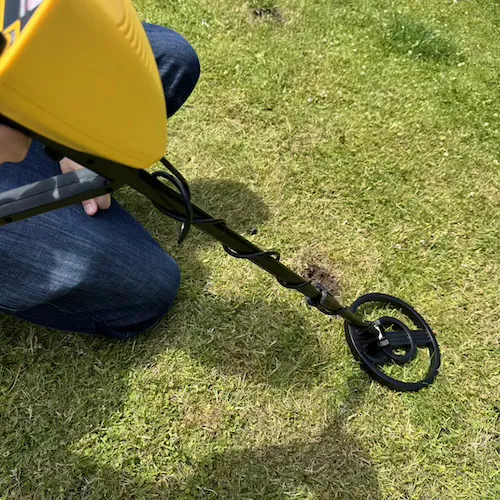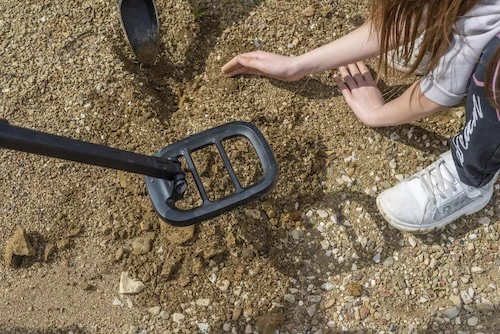How to Swing a Metal Detector: A Step-by-Step Guide

Written by Piotr Lesniewski
Detectorist • Scotland
As an Amazon Associate we earn commission from qualifying purchases. Read our full Affiliate Disclosure.
You've got your metal detector in hand, but swinging it properly isn't as straightforward as you might think. Most beginners make critical errors that cause them to miss valuable finds just inches below their coil.
The difference between a successful hunt and walking over buried treasure often comes down to your technique.
Master these five essential swing fundamentals, and you'll dramatically increase your detection depth and target recovery rate.
Key Takeaways
- Hold the coil 1-2 centimeters above ground, keeping it flat and parallel throughout the entire swing motion.
- Execute smooth side-to-side arcs spanning 3-4 feet with consistent speed, avoiding choppy or rushed movements.
- Overlap each sweep by 50% and take one step forward every 2-3 swings for complete ground coverage.
- Maintain a moderate pace of about one second per foot of sweep width for optimal target detection.
- Avoid lifting the coil at swing endpoints and prevent dragging or bouncing to maximize detection efficiency.

Proper Coil Positioning and Height Control
Two critical factors determine your metal detector's effectiveness: how high you hold the coil above the ground and whether you maintain consistent positioning throughout your sweep.
Keep your coil just 1-2 centimeters above the surface—any higher and you'll lose detection depth significantly. The coil must remain flat and parallel to the ground throughout your entire swing arc.
Avoid the common "golf swing" mistake where you lift the coil at swing endpoints. This creates coverage gaps and reduces your detector's sensitivity to deep targets.
Instead, imagine you're painting the ground with your coil, maintaining that same low, level position from left to right.
Practice smooth, controlled movements where the coil barely skims above grass, sand, or dirt without actually touching the surface.

Mastering the Side-to-Side Sweep Pattern
Once you've mastered proper coil height, your sweep pattern becomes the foundation for systematic metal detecting success.
Execute smooth, controlled side-to-side arcs spanning 3-4 feet, maintaining consistent speed throughout each sweep. Don't rush—let your detector's processor analyze each signal properly.
Overlap each sweep by 50% to ensure complete ground coverage.
Think of it like mowing grass: systematic rows prevent missed areas.
Keep your coil parallel to the ground during the entire arc, avoiding the common mistake of lifting at the ends.
Move forward slowly, taking one step every 2-3 swings. Create a grid pattern by sweeping left-to-right, then reversing direction. This methodical approach guarantees you'll cover every inch of promising ground without gaps.

Finding Your Optimal Swing Speed
While maintaining proper sweep patterns sets the foundation, your swing speed determines whether you'll detect deep targets or miss valuable finds entirely.
Start with a moderate pace—about one second per foot of sweep width. This gives your detector's processor enough time to analyze signals from deeper objects.
Test different speeds in a practice area with buried coins. You'll notice that slower swings reveal fainter signals you'd miss at faster speeds.
However, don't swing so slowly that you lose momentum and struggle to maintain smooth coil control.
Listen to your detector's audio response. If signals sound choppy or cut off, you're moving too fast. When you hear clear, full tones on known targets, you've found your optimal speed.

Walking Technique and Ground Coverage
Proper walking technique transforms your metal detecting from random wandering into systematic treasure hunting.
Move slowly—take one step every 2-3 swings to ensure thorough coverage. Don't rush; you'll miss valuable targets buried beneath your feet.
Grid your search area like mowing a lawn. Walk in straight lines, then turn and walk parallel rows back. This systematic approach prevents gaps and ensures you don't miss sections.
Mark your starting point and maintain consistent spacing between rows.
Keep your steps deliberate and measured. Quick, erratic movements cause your detector to miss faint signals from deeper targets.
Your coil needs time to process ground conditions and target responses. Think of yourself as a human GPS, methodically scanning every square foot with purpose and precision.

Common Swing Mistakes to Avoid
Even experienced detectorists fall into bad swing habits that cost them valuable finds. The most damaging mistake is the "golf swing" motion—lifting your coil at the ends of each sweep. This creates dead zones where targets go undetected.
Swinging too fast is another culprit. Your detector's processor needs time to analyze signals, and rushing means missing faint or deep targets.
Similarly, inconsistent coil height ruins your depth potential.
Keep that coil steady at 1-2 cm above ground.
Don't skip the overlap either. Swinging without 50% overlap leaves strips of unsearched ground between passes.
Finally, avoid dragging or bouncing your coil. Maintaining smooth, controlled movements with consistent pressure ensures you're detecting at maximum efficiency rather than fighting your equipment.
Conclusion
You'll master metal detecting by maintaining proper coil height and executing smooth, overlapping sweeps.
Keep your detector 1-2 cm above ground, swing in controlled 3-4 foot arcs, and move at one second per foot.
Don't rush—take deliberate steps and overlap each pass by 50%. Avoid common mistakes like tilting the coil or swinging too fast.
With consistent technique and systematic ground coverage, you'll maximize your chances of finding valuable targets on every hunt.
Author Profile

Piotr Lesniewski
"Digging up the past, one signal at a time."
Polish-born, Scotland-based, and obsessed with the beep. My passion began decades ago, exploring fields with my Dziadek (grandfather). Now, with over 10 years of digging under my belt, I'm here to share everything I've learned—unfiltered and unbiased—to help you unearth your own piece of history. No sales pitches, just real field experience.